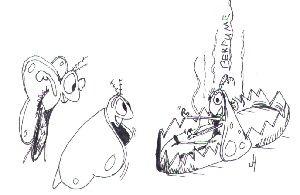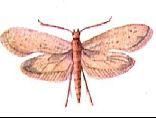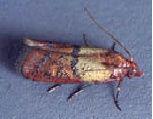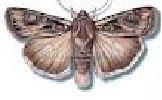Natural Solutions to Things That Bug You (62 page)
Read Natural Solutions to Things That Bug You Online
Authors: Myles Bader

 If you leave sweaty clothing in a closet the moths will find it and set up housekeeping and lay eggs.
If you leave sweaty clothing in a closet the moths will find it and set up housekeeping and lay eggs.
MOTH ORCHID TO THE RESCUE
The moth orchid or Phalaenopsis is a wonderful indoor plant because of its beauty. It has pink and white blooms that resemble a flying moth. Moderate lighting conditions make this an easy plant to grow. Moth orchids need warm temperatures but shouldn't be in direct sunlight. Keep the soil slightly moist all the time. This plant will grow better if a small amount of water is kept in the planter. Replant moth orchids every one to two years.


THE FEMALE TEMPTATION ALWAYS WORKS

 In the late spring, try hanging pheromone traps in the apple trees. They contain sticky paper and a capsule of the female hormone to attract the male. If you trap the males then they cannot fertilize the females and no eggs.
In the late spring, try hanging pheromone traps in the apple trees. They contain sticky paper and a capsule of the female hormone to attract the male. If you trap the males then they cannot fertilize the females and no eggs.
CABBAGE MOTHS
Identification:
These very small pale purple moths kill young sprouts.
TAR PAPER TRAPPER
Roofing felt or tarpaper can be very effective against cabbage moths. Make a slit in the paper and place it fully around the plant. This will stop the cabbage moths from laying eggs around the base of the cauliflower; cabbage, broccoli or Brussels sprout plants. The plant will open the slit more and more as it grows.
CLOTHES MOTHS
Identification:
 The adult moths are gold colored with reddish-gold hairs on top of its head. Their wings have a span of about ½ inch with rows of golden hairs. They like the dark areas of closets and are not attracted by light.
The adult moths are gold colored with reddish-gold hairs on top of its head. Their wings have a span of about ½ inch with rows of golden hairs. They like the dark areas of closets and are not attracted by light.
Clothes moths have been of great economic importance in the past but are rarely a problem today. Almost all insect-related clothing damage results from carpet beetles. Most clothes moth problems probably originate on imported woolen goods that are infested.
The webbing clothes moth generally is light in color and small (about ½ inch from wing tip to wing tip). There are also reddish, fluffy hairs at the top.
Female moths rarely fly until they have laid most of their eggs, so simply killing flying moths will not control them. Although clothes moths are no longer abundant, do take preventive measures for more expensive woolen or fur articles. Dry cleaning kills all stages of the insect.
Place the articles in airtight containers to prevent re-infestation. Cedar chests and moth balls do repel some moths, but will not consistently kill existing insects.
PHERMONE MOTH TRAPS TO THE RESCUE
The key to trapping moths with a pheromone moth trap is that the pheromone lure makes male moths think a female moth is nearby. The male moth follows the scent of the moth pheromone lure, and gets caught in the moth trap's sticky glue board.
MOTHS ARE ATTRACTED TO YELLOW
To trap moths, mix 1 part molasses with 2 parts white vinegar and place in a yellow container to attract moths. Clean regularly.
INDIAN MEAL MOTH
 Indian meal moth is a small moth that will reside in your home for periods of about three weeks. Indian meal moths are small (wing spread of about 5/8 inch) and have a broad, grayish band on their bronze-colored wings. Adult moths do not feed, but immature meal moths are capable of developing on almost any dried food product in the home.
Indian meal moth is a small moth that will reside in your home for periods of about three weeks. Indian meal moths are small (wing spread of about 5/8 inch) and have a broad, grayish band on their bronze-colored wings. Adult moths do not feed, but immature meal moths are capable of developing on almost any dried food product in the home.
This general feeder has been found on grain, grain products, dried fruits, dried vegetables, seeds, nuts, graham crackers, powdered milk and dog food. There usually is some webbing on the infested product, which identifies the moth. Most household infestations originate from purchase of infested foods, but some movement of the moths from outdoors is possible in warm weather.
Control of Indian meal moths requires a thorough search of all dried food, including things like dog food and bird seed that often are overlooked.
The problem will more likely have developed in foods that have not been used for some time. Small, white worms and webbing indicate sources of the problem. Discard infested foods if possible and examine the remaining food to kill any insects that are left.
The easiest way to kill Indian meal moths is to place the food package in the freezer for several days. Warming the infested food in an oven or microwave also can kill insect eggs and larvae. Temperatures of 125
F to 130
F maintained for three hours should be adequate.
Because of the potential hazard of food contamination, natural methods are not for control of Indian meal moths in houses. After treating or discarding all potential food for the moth, keep everything stored in tight containers, outdoors, or in the refrigerator for a couple of weeks. After adult moths are no longer observed, food can be returned to storage areas because the source of the infestation should be eliminated.
MILLER MOTH (Army cutworm)
 Miller moths (Army Cutworms)
Miller moths (Army Cutworms)
are the most common nuisance moth. These moths can be extremely annoying when they get into homes and cars, but they do not breed indoors and die within a few days. Army cutworm moths, more commonly known as a Miller moth are about 1 inch long and variable in color. Usually they are gray or brown with two characteristic light spots on each wing.
Miller moths have an unusual life cycle. The caterpillar stage (larvae), overwinter in the soil, primarily in alfalfa and wheat fields. In the spring, they feed and complete their development, causing some economic damage to Crops. Moths usually emerge in May or June, with the majority emerging during a short period.
Very soon after emergence, the moths migrate to higher elevations in the mountains to feed on flowering plants, crossing the heavily populated areas of the state. During this migration, some of the moths move into buildings, causing nuisance problems. They stay in the high elevations until late summer to early fall, when they return to the plains. Fall migrations are smaller and less frequently observed. Upon returning to the high plains, the moths lay eggs in the soil. Larvae begin to feed before overwintering.